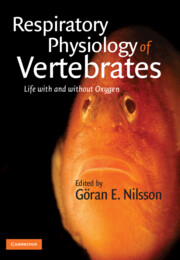2 - Sensing oxygen
Published online by Cambridge University Press: 05 June 2012
Summary
Introduction
Oxygen is required as the ultimate electron acceptor in aerobic energy production. In the long run, all vertebrates need oxygen to support metabolism. In the short term, however, some animals can cope with a total lack of oxygen (anoxia), and others can tolerate reduced oxygen levels (hypoxia). Furthermore, eutrophic aquatic systems in particular are characterized by supra-atmospheric oxygen tensions (hyperoxia) during active photosynthesis of green plants. Hyperoxic conditions may also occur in the closed system of circulation, especially near the gas gland and avascular retina of fishes (Ingermann and Terwilliger, 1982; Pelster and Scheid, 1992).
With regard to oxygen requirements, there is an intricate balance between reactions that produce energy and those that consume it. It is generally agreed that energy (and oxygen) consumption is reduced when adapting to conditions of low oxygen (e.g. channel arrest) (Hochachka and Lutz, 2001). However, even in conditions in which oxygen is not limiting, adjustments of metabolic rate occur (Rissanen et al., 2006a). Because several phenomena, at both integrative and molecular levels, have turned out to be oxygen sensitive, the search for mechanisms by which oxygen is sensed has intensified in recent years.
Several questions relate to how oxygen is sensed and how oxygen-dependent responses occur. First, what is actually sensed, when apparently oxygen-dependent phenomena occur? Secondly, which molecules are utilized in sensing oxygen? Thirdly, what are the pathways used in oxygen sensing – i.e. how is the primary signal converted to be used by the effector systems in an oxygen-dependent manner?
- Type
- Chapter
- Information
- Respiratory Physiology of VertebratesLife With and Without Oxygen, pp. 14 - 48Publisher: Cambridge University PressPrint publication year: 2010
References
- 1
- Cited by

